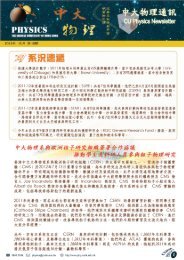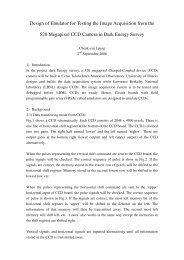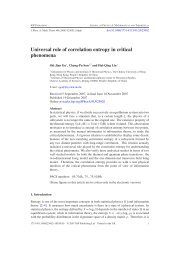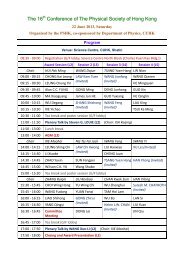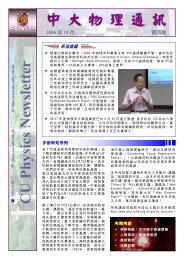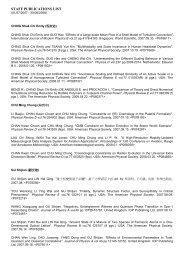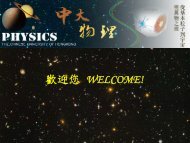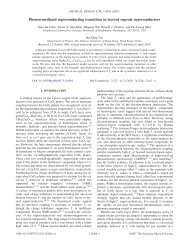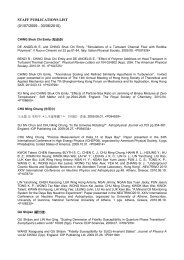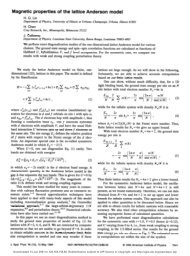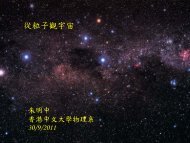Constructing soluble quantum spin models - Department of Physics ...
Constructing soluble quantum spin models - Department of Physics ...
Constructing soluble quantum spin models - Department of Physics ...
Create successful ePaper yourself
Turn your PDF publications into a flip-book with our unique Google optimized e-Paper software.
H.Y. Shik et al. / Nuclear <strong>Physics</strong> B 666 [FS] (2003) 337–360 345<br />
K−1,M<br />
∑ 1( h 2a = s<br />
†<br />
k,m<br />
4<br />
t αk,ms † k+1,m t αk+1,m + s † k,m t αk,mt † αk+1,m s k+1,m<br />
k,m=1<br />
+ t † αk,m s k,ms † k+1,m t αk+1,m + t † αk,m s k,mt † αk+1,m s k+1,m<br />
K,M−1<br />
∑ 1 (<br />
h 2b = s<br />
†<br />
k,m<br />
4<br />
t αk,ms † k,m+1 t αk,m+1 + s † k,m t αk,mt † αk,m+1 s k,m+1<br />
k,m=1<br />
(35)<br />
)<br />
,<br />
(36)<br />
+ t † αk,m s k,ms † k,m+1 t αk,m+1 + t † αk,m s k,mt † αk,m+1 s )<br />
k,m+1 ,<br />
(37)<br />
K−1,M<br />
∑ i<br />
h 3a =<br />
4 ɛ (<br />
αβγ s<br />
†<br />
k,m t αk,mt † βk+1,m t γk+1,m + t † αk,m s k,mt † βk+1,m t γk+1,m<br />
k,m=1<br />
− t † βk,m t γk,ms † k+1,m t αk+1,m − t † βk,m t γk,mt † αk+1,m s )<br />
k+1,m ,<br />
(38)<br />
K,M−1<br />
∑ i<br />
h 3b =<br />
4 ɛ (<br />
αβγ s<br />
†<br />
k,m t αk,mt † βk,m+1 t γk,m+1 + t † αk,m s k,mt † βk,m+1 t γk,m+1<br />
k,m=1<br />
h 4a =<br />
h 4b =<br />
K−1,M<br />
∑<br />
k,m=1,α≠β<br />
K,M−1<br />
∑<br />
k,m=1,α≠β<br />
− t † βk,m t γk,ms † k,m+1 t αk,m+1 − t † βk,m t γk,mt † αk,m+1 s )<br />
k,m+1 ,<br />
) , (39)<br />
(40)<br />
1<br />
4 t† αk,m t (<br />
βk,m tαk+1,m t † βk+1,m − t† αk+1,m t βk+1,m<br />
1<br />
4 t† αk,m t (<br />
βk,m tαk,m+1 t † βk,m+1 − t† αk,m+1 t )<br />
βk,m+1 .<br />
Then, based on the arguments we have in previous sections, the conditions for the<br />
completely dimerized state to be an eigenstate are<br />
2J 2 = J 3 + J 4 , J 6 + J 7 = J 5 + J 8 .<br />
(41)<br />
Again, as in the previous section, same conditions hold for cases with <strong>spin</strong> S other<br />
than 1/2. Conditions Eq. (41) could have various forms. For example, we can let J 6 = J 7<br />
due to symmetry and let J 8 = 0togetJ 5 = 2J 6 ,orletJ 5 = J 6 = J 7 = J 8 and study their<br />
energy specturms. In fact, then the model could be maped into coupled <strong>spin</strong> chains with<br />
spatial anisotropy. Quantum phase transitions are expected. We also remark that one can<br />
obtain <strong>soluble</strong> bilayer net <strong>spin</strong> model with inter-bilayer couplings under similar conditions.<br />
5. Three-dimensional exactly <strong>soluble</strong> model<br />
In this section, the bond operator method is used to determine the condition(s) required<br />
for the completely dimerized state to be an eigenstate <strong>of</strong> a three-dimensional model H 3D ,<br />
defined by the Hamiltonian,<br />
K,L,M<br />
∑<br />
K,L,M−1<br />
H 3D = 2J 1 S k,l,m · S ′ k,l,m + 2 ∑<br />
J˜<br />
1 S ′ k,l,m · S k,l,m+1<br />
k,l,m=1<br />
k,l,m=1



